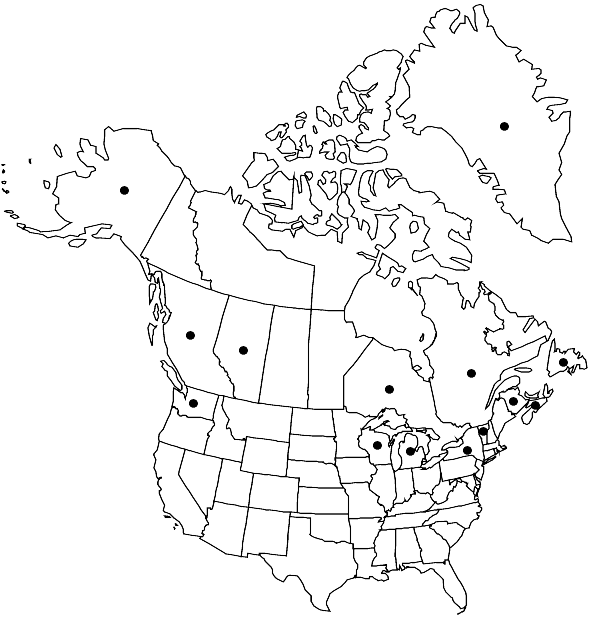Difference between revisions of "Schistidium apocarpum"
Bryol. Europ. 3: 99. 1845,.
FNA>Volume Importer |
FNA>Volume Importer |
||
| Line 9: | Line 9: | ||
|name=Grimmia apocarpa | |name=Grimmia apocarpa | ||
|authority=Hedwig | |authority=Hedwig | ||
| + | |rank=species | ||
|publication_title=Sp. Musc. Frond., | |publication_title=Sp. Musc. Frond., | ||
|publication_place=76. 1801 | |publication_place=76. 1801 | ||
| Line 15: | Line 16: | ||
|name=Schistidium lancifolium | |name=Schistidium lancifolium | ||
|authority=H. H. Blom | |authority=H. H. Blom | ||
| + | |rank=species | ||
}} {{Treatment/ID/Synonym | }} {{Treatment/ID/Synonym | ||
|name=Schistidium umbrosum | |name=Schistidium umbrosum | ||
|authority=(J. E. Zetterstedt) H. H. Blom | |authority=(J. E. Zetterstedt) H. H. Blom | ||
| + | |rank=species | ||
}} | }} | ||
|hierarchy=Grimmiaceae;Grimmiaceae subfam. Grimmioideae;Schistidium;Schistidium apocarpum | |hierarchy=Grimmiaceae;Grimmiaceae subfam. Grimmioideae;Schistidium;Schistidium apocarpum | ||
| Line 42: | Line 45: | ||
-->{{#Taxon: | -->{{#Taxon: | ||
name=Schistidium apocarpum | name=Schistidium apocarpum | ||
| − | |||
|authority=(Hedwig) Bruch & Schimper | |authority=(Hedwig) Bruch & Schimper | ||
|rank=species | |rank=species | ||
| Line 57: | Line 59: | ||
|publication year= | |publication year= | ||
|special status= | |special status= | ||
| − | |source xml=https://jpend@bitbucket.org/aafc-mbb/fna-data-curation.git/src/ | + | |source xml=https://jpend@bitbucket.org/aafc-mbb/fna-data-curation.git/src/f50eec43f223ca0e34566be0b046453a0960e173/coarse_grained_fna_xml/V27/V27_282.xml |
|subfamily=Grimmiaceae subfam. Grimmioideae | |subfamily=Grimmiaceae subfam. Grimmioideae | ||
|genus=Schistidium | |genus=Schistidium | ||
Revision as of 21:00, 16 December 2019
Plants in open tufts or mats, olivaceous to brownish (black), sometimes with yellowish tones. Stems 1.2–12 cm, central strand weak or absent. Leaves erect or curved, rarely (falcate-) secund when dry, ovate-lanceolate, sharply keeled distally, (1.3–)1.7–2.5(–3.2) mm, 1-stratose or rarely 2-stratose in striae distally; margins usually recurved throughout or to just before the apex, usually denticulate distally, 1 or 2-stratose; apices acute or sub-obtuse; costa percurrent or excurrent as a smooth or weakly denticulate, occasionally decurrent awn, abaxial surface often papillose; basal marginal cells usually quadrate; distal laminal cells mostly short-rectangular, 8–10 µm wide, smooth, sinuose. Sexual condition autoicous. Capsule dark red or brown, short-cylindric, 0.7–1.3 mm; exothecial cells usually quadrate, sometimes mixed with short-elongate or oblate cells, thin-walled, usually trigonous; stomata present; peristome patent or erect, often twisted, 350–600(–700) µm, red, densely papillose, usually perforated. Spores 11–14(–19) µm, granulose or smooth.
Phenology: Capsules mature late spring to early summer.
Habitat: Rocks in somewhat shaded habitats
Elevation: low to moderate elevations (0-1500 m)
Distribution

Greenland, Alta., B.C., N.B., Nfld. and Labr. (Nfld.), N.S., Ont., Que., Alaska, Mich., N.Y., Vt., Wash., Wis., Eurasia.
Discussion
Although H. H. Blom (1996) considered Schistidium apocarpum to be restricted in the flora area to the eastern portions of North America, it is more widespread and scattered across the continent. The denticulate leaf margins, papillose abaxial costal surface, short-cylindrical capsules, and the thin-walled, often evenly quadrate exothecial cells are distinguishing characters. The long peristome teeth are also useful in identifying S. apocarpum. In good condition the peristome can only be confused with that of S. trichodon, which differs in the darker, often black color of its plants, the peristome teeth often forming a dome, and the cylindrical capsules that retain the columella.
Selected References
None.